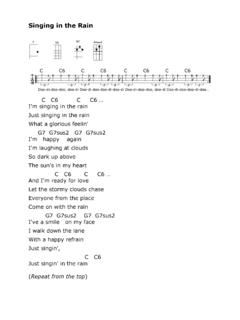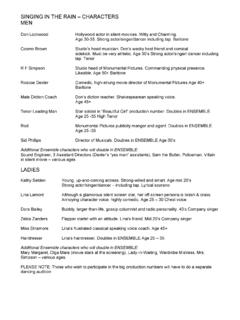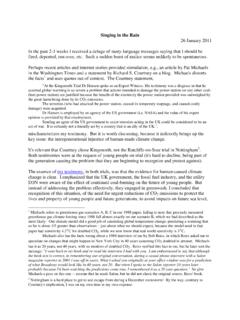Transcription of Singin’ In the Rain, (1952) - Think 360 Arts for Learning
1 Film Study lecture on singin in the rain ( 1952 ) Compiled by Dr. Jay Seller 1 Primary source film historian Ronald Haver, compiled and Copyright 2004 by Jay Seller, PhD Facts on celebrities from the Internet Movie Database singin in the rain , ( 1952 ) Directed by Stanley Donen Screenwriters Betty Comden and Adolf Green Chapter 1: singin in the rain Was voted the 10th Greatest Film of all time by Entertainment Weekly, being the highest ranked musical. This film is the favorite of critics, fans and most everyone in general, a film that encourages repeat viewings. PowerPoint presentation includes: 1895, considered to be the birth of cinematography in America. 1895-1927, the Silent Era of film. 1927, sound was introduced. First film was produced by Warner Brothers Studio, The Jazz Singer, the Story of Al Jolson.
2 1930 s, is considered the Golden Era of Radio, with such shows as The Green Hornet, George Burns and Gracie Allen, Abbott and Costello. 1940 s, is considered the Golden Era of Film. This era started in 1939 with such films as The Wizard of Oz, Wuthering Heights, and Gone with the Wind. 1939, Television was invented and introduced at the New York World s Fair, but didn t begin mass production until after World War II. 1950 s, is considered the Golden Era of Television, with such hits as I Love Lucy (1951-1957), Ed Sullivan Show and The Milton Berle Comedy Cavalcade. One of the reasons this film is interesting to watch is that it depicts this time period of the transition from silent movies to talking pictures 1927-1929. The stories in this movie are based on true stories that happened during this transition.
3 The inspiration of producer Arthur Freed, who wrote the title song in 1928 for MGM s A Broadway Melody. All of these songs were in the libraries of MGM studios and they were all considered hits of their time, so by releasing a movie, utilizing these songs, it was a sure win and profit maker for the studio. The script was written after the songs, and so it had to generate a plot into which the songs would fit. Pan and Scan and Letterbox and Widescreen formats for DVD and Videotaped sales. A widescreen image is a film, computer, or television image with a wider and shorter aspect ratio than the standard Academy frame developed during the classical Hollywood cinema era. Silent film was projected at a ratio of four units wide to three units tall, often expressed as 4:3 or :1.
4 The addition of sound-on-film soundtracks and a thicker frame line in order to hide Film Study lecture on singin in the rain ( 1952 ) Compiled by Dr. Jay Seller 2 Primary source film historian Ronald Haver, compiled and Copyright 2004 by Jay Seller, PhD Facts on celebrities from the Internet Movie Database physical splices in prints caused the frame dimensions to standardize by 1932 to Academy format, which is actually but often erroneously called Widescreen was first widely used in the late 1920s in some shorts and newsreels, including Fox Grandeur News and Fox Movietone Follies of 1929, both released on May 26, 1929 in New York City in the Fox Grandeur process. Other films shown in widescreen were the musical Happy Days (1929) which premiered at the Roxy Theater, , on February 13, 1930, starring Janet Gaynor and Charles Farrell and a 13 year old Betty Grable as a chorus girl, and the western The Big Trail (1930) starring John Wayne and Tyrone Power, Sr.
5 Which premiered at Grauman s Chinese Theatre in Hollywood on October 2, 1930, both of which were also made in the 70mm Fox Grandeur process. RKO released Danger Lights with Jean Arthur, Louis Wolheim, and Robert Armstrong on August 21, 1930 in a 65mm widescreen process known as NaturalVision, invented by film pioneer George K. Spoor. United Artists released The Bat Whispers directed by Roland West on November 13, 1930 in a 70mm widescreen process known as Magnifilm. By 1932, the Depression had forced studios to cut back on needless expense and it wasn't until the 1950s that wider aspect ratios were again used in an attempt to stop the fall in attendance due, partially, to the emergence of television in the Source: Wikipedia Pan and scan is one method of adjusting widescreen film images so that they can be shown within the proportions of an ordinary 4:3 aspect ratio television screen, often cropping off the sides of the original widescreen image to focus on the composition s most important aspects.
6 Some film directors and film enthusiasts disagree with pan and scan cropping, because it can remove up to 45% (on :1 films) of the original image, changing the director's original vision and intentions. The vertical equivalent is known as tilt and scan or reverse pan and scan . Source: Wikipedia Letterboxing is the practice of transferring widescreen film to video formats while preserving the film's original aspect ratio. Since the video display often has a square aspect ratio, the Film Study lecture on singin in the rain ( 1952 ) Compiled by Dr. Jay Seller 3 Primary source film historian Ronald Haver, compiled and Copyright 2004 by Jay Seller, PhD Facts on celebrities from the Internet Movie Database resulting videographic image has mattes (black bars) above and below it; LTBX is the identifying acronym for films and images so formatted.
7 Letterboxing is the alternative to the full-screen, pan-and-scan transference of a widescreen film image to videotape or videodisc. In pan-and-scan transfers, the original image is cropped to the :1 (4:3) aspect ratio of the standard television screen, whereas letterboxing preserves the film's original image composition seen in the cinema. Letterboxing was for use in 4:3 television displays when widescreen television was in its technologic infancy. Any Academy ratio ( :1) film will appear stretched and distorted to fill the widescreen television display, avoided by pillar boxing the image either via the TV set or the DVD player. Occasionally, an image broadcast at 4:3 appears letterboxed on a 4:3 or a 16:9 or wider aspect ratio television screen.
8 This effect is common on personal video websites and old documentaries, neither the original image s top and bottom have been matted or it appears stretched and wider than normal, making the people appear fat. Source: Wikipedia Aspect Ratio: Television 4:3, Film 4:6, demonstrate on the image in front of them. Chapter 2: Main Title Interesting shot here; if you look carefully you can see the cars are 1936 automobiles and not 1927 automobiles. This is lifted from the original version of A Star Is Born (1936), and is what we call stock footage. Stock footage is footage that is taken from a previous movie and inserted. MGM Studio incorporated in 1924. Original budget was million, unsure of the final budget as studio executives were replaced during production.
9 Betty Comden stated that these songs should stay in their era, as a result they came up with the idea of using the transitional period of 1927 as their setting. Chapter 3: Dora Bailey at The Chinese This opening, this premiere scene is one of three openings that was written for the film by Betty Comden and Adolph Green. They had worked previously with Arthur Freed and Leonard Bernstein. Came to Hollywood in 1950 to work on Freed s film singin in the rain . Only thing they knew was the title of the film and that the film was to be written around Freed s music. Film Study lecture on singin in the rain ( 1952 ) Compiled by Dr. Jay Seller 4 Primary source film historian Ronald Haver, compiled and Copyright 2004 by Jay Seller, PhD Facts on celebrities from the Internet Movie Database The script was written after the songs, and so it had to generate a plot into which the songs would fit.
10 After finding out that they were to use the songs of Arthur Freed (also the producer) and Nacio Herb Brown, screenwriters Comden and Green went on strike claiming their contract stated that they were to write the lyrics, unless the score was by either Irving Berlin, Cole Porter, or Richard Rodgers and Oscar Hammerstein II. Two weeks later, and with a new agent, they discovered that there was no such clause, it was only a fabrication of their former agent, and subsequently got back to work. The role of Cosmo was written with Oscar Levant in mind, but instead was immortalized by Donald O Connor Two Types of mistakes in Films 1. Continuity this is a mistake in the editing, where something doesn t match from one cut to the next, glass of wine, costume, or prop.









